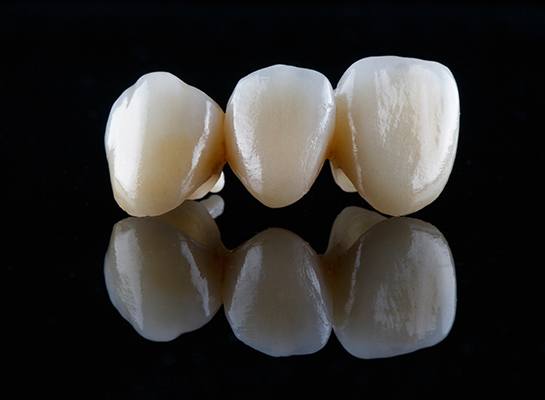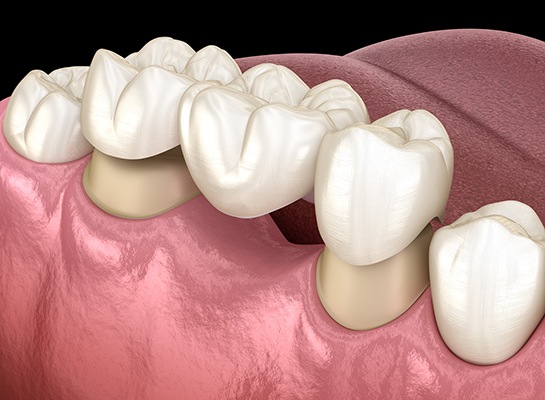Dental Bridges Hanover
Have a Gap in Your Grin? Call Us

Why force yourself to live with a missing tooth? Here at Dental Designs in Maryland, we have multiple ways to fill in the empty space in your smile. If you’ve lost a single tooth or multiple teeth in a row, we may suggest getting a dental bridge to restore your ability to chew, speak, and smile. Please give us a call if you’re interested in learning more about dental bridges as an option for tooth replacement.
Why Choose Dental Designs of Maryland for Dental Bridges?
- Replacement Teeth Made From High-Quality Materials
- Dental Implants Placed and Restored In-Office
- Team That Utilizes State-of-the-Art Technology
What is a Dental Bridge?

A dental bridge is made by suspending free-standing replacement teeth known as pontics between a pair of crowns (with the exact number of pontics varying depending on how many teeth have been lost). The pontics are what will ultimately fill in the empty space in your smile. Meanwhile, the crowns keep the entire prosthesis secured in place. When a dental bridge is made out of tooth-colored materials, it can blend right in with your natural teeth.
Types of Dental Bridges

You can have a dental bridge attached to your natural teeth or a pair of dental implants. During your initial consultation, our team will examine your mouth and consider your unique situation before determining which kind of bridge is the best choice for you. Here’s a brief summary of your options:
Traditional Dental Bridge
To qualify for a traditional dental bridge, the teeth on either side of the gap in your smile must be in good health overall. A small amount of enamel will be removed from the teeth in question so that a bridge can be placed. This type of dental bridge may be a good fit for you if you have at least one missing tooth.
Implant Bridge
If you have good overall oral health as well as a sufficient amount of bone in your gums, you may be a candidate for an implant bridge. This type of bridge is attached to a pair of surgically placed implant posts that can mimic the functions of natural tooth roots. You may be able to benefit from an implant bridge if you have lost three or more consecutive teeth.
The Benefits of Getting a Dental Bridge

Since a dental bridge fills in the empty space left by missing teeth, it can help prevent the rest of your smile from drifting out of alignment. Furthermore, it will be easier to show off your grin with full confidence thanks to your customized, natural-looking prosthesis.
Taking care of a dental bridge is relatively simple; in fact, you can brush it the same way you would the rest of your smile. As long as you’re diligent about taking care of your bridge, you can generally expect it to last for many years before it needs to be replaced.
Dental Bridges FAQs
Can You Take a Dental Bridge Out?
No, dental bridges are designed to remain fixed to your tooth after placement. You’ll need a dentist to remove your bridge for any adjustments and repairs, and we don’t recommend trying to take it out on your own.
Your dental bridge should fit snugly and stay in place for several years, but if it “pops off” or falls out for any reason, give us a call right away! We’ll figure out why it came loose, make any necessary adjustments, and replace or reattach it promptly.
Is Getting a Dental Bridge Painful?
Rest assured, we’ll numb your teeth and surrounding gums with a local anesthetic before placing your dental bridge. Most patients find this is enough to keep them comfortable during their treatment – though we do offer dental sedation for patients who need something a bit stronger!
Where you’re more likely to experience some discomfort is during post-op recovery. Your teeth will likely feel sore after being prepped and capped with a new restoration. Fortunately, this type of ache is usually manageable with help from OTC pain relievers. If your pain is severe or lasts more than a week or two, please contact our office so we can help!
How Long Should a Dental Bridge Last?
On average, dental bridges last for about 15 years. How well you care for your restoration will determine whether your bridge lasts longer – or shorter! – than that average. To get the most out of your new teeth, we recommend:
- Brushing your teeth twice daily
- Flossing at least once per day
- Visiting our office for regular checkups and cleanings
- Avoiding bad oral habits like nail-biting, smoking, or using your teeth as tools
How Many Teeth Can a Dental Bridge Replace?
We find that most patients only need to replace one or two teeth, but a dental bridge can replace up to four missing teeth in a row. Any more than that, and the restoration starts to become unstable simply due to physics.
Can Dental Bridges Be Whitened?
No, unfortunately teeth whitening isn’t as effective on dental bridges as it is natural teeth. The whitening agents we use are specially formulated to slip between the pours of your enamel, and can’t penetrate inorganic materials to remove stains.
We know having a white, bright smile is important, and don’t worry – you won’t be out of options just because you have a bridge! In this situation, we recommend getting a teeth whitening treatment first, then replacing your bridge. That way, we can simply color-match the new restoration to your newly whitened smile.

